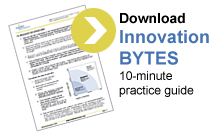 During times of crisis your organization NEEDS to get more innovative to MAXIMIZE its human capital. We can see this in the statistics from a prologue in Business week about Fortune 500 companies that have vanished. According to Arie de Geus, author of The Living Company, a “full one-third of the companies listed in the 1970 Fortune 500 … had vanished by 1983 — acquired, merged, or broken to pieces.”
During times of crisis your organization NEEDS to get more innovative to MAXIMIZE its human capital. We can see this in the statistics from a prologue in Business week about Fortune 500 companies that have vanished. According to Arie de Geus, author of The Living Company, a “full one-third of the companies listed in the 1970 Fortune 500 … had vanished by 1983 — acquired, merged, or broken to pieces.”
WHO CAN INNOVATE?
 The answer is easy…EVERYONE! It’s a fact that everyone is naturally creative and innovative. The typical characteristics of innovators include having an open mind, being curious with humble inquiry, and seeing the world with new eyes to integrate new technologies and/or ideas. Although you may have “retired” your innate innovative ability, know you may reactivate it at any time!
The answer is easy…EVERYONE! It’s a fact that everyone is naturally creative and innovative. The typical characteristics of innovators include having an open mind, being curious with humble inquiry, and seeing the world with new eyes to integrate new technologies and/or ideas. Although you may have “retired” your innate innovative ability, know you may reactivate it at any time!
WHAT IS INNOVATION?
We define innovation as a formula with three essential elements:
Innovation = New ideas + action that produces value
NEW IDEAS…
New ideas that lead to innovation require clarity as to “the problem to be solved” or “the job to be done.” Once a problem is clearly defined, then new ideas can be generated. Innovation requires we bring in diversity of thought and be open to accepting alternative viewpoints that don’t necessarily align with current beliefs. In fact, tension and being challenged is fertile ground for generating new ideas. It is also easier to build upon vastly different ideas than it is when the pool of possibilities is too similar.
…+ ACTION
Rule number one when it comes to taking action in a culture of innovation is to accelerate your rate of failure. Our motto is “Fail often and fast at the lowest cost to find the success.” If the implementation of a new idea has failed, be careful not to kill the idea because of it. A great idea is always a great idea, so keep in mind that it may take time for the right technology to come along for the idea to come to life.
As it takes a village to raise a child so will it take a village to bring a truly innovative idea to life. In that regard, a strong and diverse collaborative team can perform miracles. To foster successful action is to trust your people. The gift of letting people do their job in their own way is important to creating a healthy culture of innovation.
…THAT PRODUCES VALUE
Value is demonstrated when a new idea is accepted and used. Value can be tangible – as in increased profits, the creation of jobs or changes in observable behavior. Value can also be intangible – as in changes in attitudes, thoughts and beliefs. Value is ultimately realized as a competitive advantage for your organization.
ARE YOU READY FOR INNOVATION?
To realize the potential of innovation, your organization has to be “innovation-ready,” which means:
- The leadership understands the true value of innovation
- The leadership recognizes if and when the current rate of innovation is not sufficient to be competitive
- The leadership commits to promoting, rewarding and sustaining the culture and climate of innovation
NOW WHAT?
Strengthen your innovation potential with a simple innovation strategy; see Innovation Bytes for 10-minute tips.
By Natasha Tong





 Posted by mindfulinnovation
Posted by mindfulinnovation 

